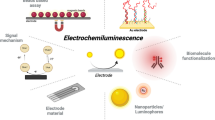Abstract
We report herein a novel chemiluminescence (CL) phenomenon triggered by light irradiation when a fluorescent dye, for example hematoporphyrin, fluorescein, eosin, or methylene blue is present in the luminol solution. A possible mechanism is proposed for the photoinduced chemiluminescence (PICL) reaction. Compared with reported methods for CL triggering, for example flow-injection, static reagent injection, and the electrochemical technique, the proposed in-situ PICL method presented has three advantages. First, the method is more selective, because the PICL signal of the target fluorescent dyes is initiated by excitation at a selective wavelength only. Second, the space and time resolution of the PICL method are better. Last, and most important, compared with injecting a reagent or inserting a electrode into the CL system to initiate the CL reaction, with the in-situ PICL method there is no physical interference with the target detecting system. All these advantages of the PICL method indicate it has many potential applications in the analytical sciences. The proposed method was applied to analysis of urine containing adrenaline. The linear range for adrenaline is 2.0 × 10−10–1.0 × 10−7 g mL−1 and the detection limit is 6.0 × 10−11 g mL−1.

Schematic PICL Mechanism for the CL reagents-fluorescence dyes systems









Similar content being viewed by others
References
Kannan B, Thankiah LG, Sohail S, Ichiro M, Thorsten W (2007) Spatially resolved total internal reflection fluorescence correlation microscopy using an electron multiplying charge-coupled device camera. Anal Chem 79:4463–4470
Reyheller C, Kubik S (2007) Selective sensing of sulfate in aqueous solution using a fluorescent bis(cyclopeptide). Org Lett 9:5271–5274
Yin HM, Heazlewood B, Stamford P, Klaas Nauta B, Bacskay GB, Kable SH, Schmidt TW (2007) Laser-induced fluorescence spectrum of 3-vinyl-1H-indene. J Phys Chem A 111:3306–3312
Inoue G, Akimoto H, Okuda M (1979) Laser-induced fluorescence spectra of CH3O. Chem Phys Lett 63:213–216
Inoue G, Akimoto H, Okuda M (1980) Spectroscopy of the CH3O A2A1–X2E system by laser-excited fluorescence method. J Chem Phys 72:1769–1775
Ishow E, Tauc P, Chauvat D, Mendona CR, Piovesan E (2007) Two-photon fluorescent holographic rewritable micropatterning. J Am Chem Soc 129:8970–8971
Victor Vargas C (2004) Time-resolved fluorescence of salicylideneaniline compounds in solution. J Phys Chem A 108:281–288
Pribik R, Aslan K, Zhang YX, Geddes CD (2008) Metal-enhanced fluorescence from chromium nanodeposits. J Phys Chem C 112:17969–17973
Wolfbeis OS, Helmut O, Herbert K, Hermann M (1984) A fast responding fluorescence sensor for oxygen. Mikrochim Acta [Wien] 1:153–158
Bhattacharyya M, Chaudhuri U, Poddar RK (1990) Evidence for cooperative binding of chlorpromazine with hemoglobin: equilibrium dialysis, fluorescence quenching and oxygen release study. Biochem Biophys Res Commun 167:1146–1153
Lakowicz JR (1999) Principles of Fluorescence Spectroscopy. Kluwer Academic/ Plenum Publishers, New York
Valeur B (2001) Molecular Fluorescence: Principles and Applications. Wiley– VCH
Agel G, Nultsch W (1987) Effects of gassing, pH, quenching agents and photodynamically active compounds on photobleaching and photoinhibition of the cyanobacterium Anabaena variabilis. Arch Microbiol 149:168–172
Lu C, Song GQ, Lin JM (2006) Reactive oxygen species and their chemiluminescence-detection methods. Trends Anal Chem 25:985–995
1Monroe BM (1985) In: Frimer AA (ed) Singlet Oxygen: Physical and Chemical Aspects, vol 1. CRC Press, Boca Raton, pp 177–224
Beghetto C, Renken C, Eriksson O, Joril G, Bernardi P, Ricchelli F (2000) Implications of the generation of reactive oxygen species by photoactivated calcein for mitochondrial studies. Eur J Biochem 267:5585–5592
Silvestre CIC, Santos JLM, Lima JLFC, Zagatto EAG (2008) Single reaction interface flow system for chemiluminescent monitoring of mannitol based on its hydroxyl radical scavenger activity. Talanta 77:518–521
McCord JM, Fridovich I (1969) Superoxide Dismutase: an enzymic function for erythrocuprein(hemocuprein). J Biol Chem 244:6049–6055
Klug D, Rabani J, Fridovich I (1972) A direct demonstration of the catalytic action of superoxide dismutase through the use of pulse radiolysis. Ibid 247:4839–4842
Ambrosio G, Flaherty JT (1992) Effects of the superoxide radical scavenger superoxide dismutase, and of the hydroxyl radical scavenger mannitol, on reperfusion injury in isolated rabbit hearts. Cardiovasc Drugs Ther 6:623–632
Hu YZ, Jiang LJ (1996) Generation of semiquinone radical anion and reactive oxygen (1O2, O2 •− and •OH) during the photosensitization of a water-soluble perylenequinone derivative. J Photochem Photobiol B 33:51–59
Gerdes R, Wohrle D, Spiller W, Schneider G, Schnurpfeil G, Schulz-Ekloff G (1997) Photo-oxidation of phenol and monochlorophenols in oxygen-saturated aqueous solutions by different photosensitizers. J Photochem Photobiol A: Chem 111:65–74
Ozoemena K, Kuznetsova N, Nyokong T (2001) Photosensitized transformation of 4-chlorophenol in the presence of aggregated and non-aggregated metallophthalocyanines. J Photochem Photobiol A 139:217–224
Viola A, Hadjur C, Jeunet A, Julliard M (1996) Generation of semiquinone radical anion and reactive oxygen (1O2, O2 −• and OH) during the photosensitization of a water-soluble perylenequinone derivative. J Photochem Photobiol B 32:49–58
Saito I, Matsuura T (1981) Formation of superoxide ion from singlet oxygen. Use of a water-soluble singlet oxygen source. J Am Chem Soc 103:188–190
Acknowledgements
Financial support from the National Natural Science Foundation of China (no. 20575040) is gratefully acknowledged.
Author information
Authors and Affiliations
Corresponding author
Rights and permissions
About this article
Cite this article
Ma, M., Diao, F., Zheng, X. et al. Selective light-triggered chemiluminescence between fluorescent dyes and luminol, and its analytical application. Anal Bioanal Chem 404, 585–592 (2012). https://doi.org/10.1007/s00216-012-6123-3
Received:
Revised:
Accepted:
Published:
Issue Date:
DOI: https://doi.org/10.1007/s00216-012-6123-3




